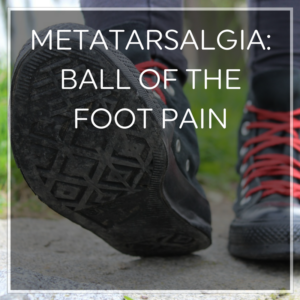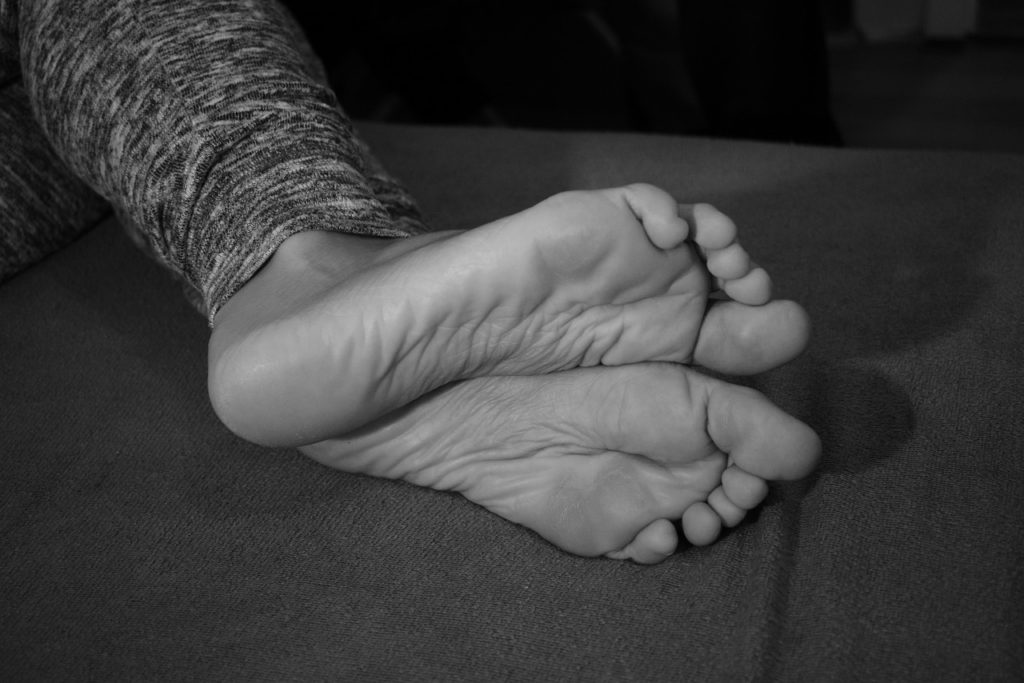 If you’ve been suffering from foot pain near the ball of your foot, you could be experiencing metatarsalgia–the medical term for pain and inflammation in the five metatarsal heads, which are located at the base of each toe.
If you’ve been suffering from foot pain near the ball of your foot, you could be experiencing metatarsalgia–the medical term for pain and inflammation in the five metatarsal heads, which are located at the base of each toe.
Each of your five toes are connected to a metatarsal bone to help you walk, run, jump, and stand properly by absorbing impact and balancing your weight.
When these metatarsals are compromised, you’ll notice symptoms in the area where the metatarsal heads meet your toe bones–also known as the ball of your foot.
While metatarsalgia can have many causes, the symptoms almost always present as inflammation, pain, numbness, and tenderness in the ball–rather than the arch or heel–of the foot.

Is Your Foot Pain Metatarsalgia?
While it might seem like metatarsalgia would be easy to identify through the hallmark pain in the ball of the foot, when symptoms become severe, the pain may be felt throughout the entire foot.
To diagnose metatarsalgia, your doctor will perform an exam, ask you questions about your activity level and any conditions that may influence your metatarsals, and potentially perform an X-ray to rule out a fracture or bone abnormality.
If you have several of the following symptoms, it’s likely that the pain you’re experiencing is metatarsalgia:
- Pain that is primarily located in the ball of the foot; however, if the pain is severe, it may be difficult to pinpoint.
- Numbness where the toes meet the foot
- Pain that ranges from dull and aching, to sharp pain in the ball of the foot
- Increased pain when you place weight on the foot, stand on tiptoe, or walk barefoot
- Pain that increases, rather than improves somewhat, while walking or moving
- The sensation that you have a small stone or object beneath your foot while you are walking, even while barefoot
Causes of Pain in the Ball of the Foot

Since metatarsalgia is an umbrella term that doctors use to describe pain in the ball of the foot, this condition can have several causes, including the following:
- Genetic abnormalities: Some people simply have longer metatarsal bones. If that’s the case, you’re more likely to develop pain in the ball of your foot, since longer metatarsal bones have a harder time balancing your weight and movements properly.
- The aging process: As we get older, the fatty tissues in our bodies become thinner and sustain more wear and tear. The metatarsals in the ball of your foot are protected by fatty tissue, and as aging wears this tissue down, the ball of your foot is more prone to injury.
- Abnormal arches: Whether your arches or high or flat, an abnormal arch places additional strain on the metatarsals in your feet.
Obesity: Carrying extra weight places more strain and wear on both the fatty pad in your arches, as well as the metatarsals in the ball of your foot. - Nerve disorders: Conditions like diabetic neuropathy and neuromas, which impact the nerves in your feet, can lead to pain in the ball of the foot.
- Arthritis: Because the metatarsal heads are joints, conditions like arthritis, a degenerative disease that impacts the joints in your body, can cause pain in your metatarsals.
- Sports and intense exercise: Exercises and sports that include movements that place heavy impact on the ball of the foot, such as soccer, basketball, jogging, or dance, can lead to overuse and injury.
- Improper footwear: Shoes that place a lot of pressure on the ball of the foot (such as high heels), and shoes that don’t provide padding or support for the arch and ball of the foot can place a great deal of strain on the metatarsals.
- Freiberg disease or Sesamoiditis: These two conditions both involve breakage or severe inflammation in the metatarsals.
Treating and Preventing Metatarsalgia

Identifying the cause of your metatarsalgia is the first and most important step in treating it. Since pain in the ball of the foot can have so many root causes, identifying the correct one is vital to preventing additional strain and damage to the metatarsals.
In addition to treating the cause of your metatarsalgia, it’s important to treat the symptoms for both pain relief and to avoid additional damage. Most treatments can be done at home, for little or no cost:
- Stretching and strengthening the muscles and tendons in your Achilles tendon and feet to reduce the amount of pressure on the ball of your foot.
- Wearing properly fitting shoes that cushion and support your arch and the ball of your foot.
- Wearing orthotic inserts to raise your arch to the appropriate height and decrease pressure on the ball of your foot
- Giving yourself adequate rest between forms of exercise or activity that put strain on the ball of your foot
- Icing the ball of your foot for 15-20 minutes, twice each day
- Using NSAIDs as needed to reduce swelling and inflammation
- Maintain a healthy weight through low-impact exercise and a healthy diet to reduce strain on the metatarsals
In many cases, metatarsalgia will resolve on its own with at-home treatment and proper attention. However, if the pain in the ball of your foot is ongoing, severe, or you suspect it may be caused by another underlying condition, it’s very important to see a doctor. In very rare cases, injections or surgery may be recommended as a last resort.
Most of the time, our metatarsals do their job without complaint, successfully helping us balance and move around. But when metatarsalgia strikes, it’s critical to give the ball of your foot the attention and rest it deserves!



